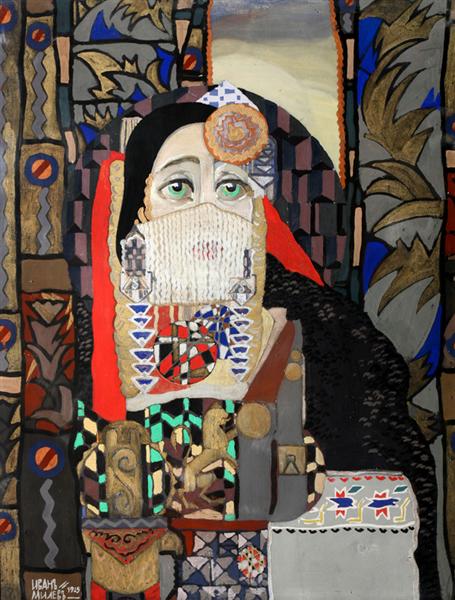Beskrivelse
Ivan Milev, en fremragende bulgarsk maler i det tyvende århundrede, er kendt for sit bidrag til udviklingen af symbolik og modernistisk kunst i Bulgarien. Hans arbejde "Ahinora" fra 1925 er et fascinerende eksempel på hans evne til at flette elementer i mytologi og bulgarsk kultur med en markant visuel stil. Maleriet præsenterer et rigt visuelt aspekt, der inviterer til en dyb udforskning, styret af det livlige kromatiske interval og den sammensatte kompleksitet, der kendetegner Milevs arbejde.
I "Ahinora" ser det ud til, at den centrale figur, der fremkalder en luft af mystik og højtidelighed, er i en tilstand af dyb overvejelse. Den portrætterede kvinde er omgivet af en glorie af lys, der understreger dens betydning, hvilket antyder, at hun kunne være en mytologisk eller symbolsk figur. Hans rolige udtryk og hans dansersca -position opretter en øjeblikkelig forbindelse med seeren, hvilket skaber en intrige omkring hans identitet og mening. Repræsentationen af den kvindelige figur er et tilbagevendende tema i Milevs arbejde, hvor han ofte udforsker dualiteten af det hellige og det vanhellige.
Sammensætningen er omhyggeligt afbalanceret, med figuren, der besætter et centralt sted, der tiltrækker udseendet. Mønstre og former, der omgiver Ahinora, er komplicerede og flydende, hvilket antyder en naturlig og næsten æterisk bevægelse, der står i kontrast til styrken i deres figur. Denne spænding mellem dynamikken og den statiske giver seeren mulighed for at opleve en slags visuel tur, hvor hvert element er sammenflettet for at fortælle en historie, der resonerer på et dybere niveau.
De farver, der bruges i "Ahinora", er især bemærkelsesværdige. Paletten indeholder varme toner, der antyder en atmosfære af følelsesmæssig varme, mens de mørkeste og dybe nuancer giver en følelse af dybde og mysterium. Blandingen af farve og lys i arbejdet tilføjer en næsten teaterdimension, hvilket får den visuelle oplevelse til at indhylle. Milev bruger lys ikke kun som en kilde til belysning, men også som et middel til at formidle de følelsesmæssige tilstande for dens karakterer.
Arbejdet afslører også indflydelsen fra folkekunst og bulgarske traditioner, som er tydelige både i valget af figuren og i de dekorative motiver, der omgiver det. Dette afspejler Milevs bestræbelser på at redde og give synligheden til det kulturelle rigdom i sit land, hvilket unikt fusionerer traditionelle elementer med strømme i europæisk modernisme. Forbindelsen med forfædres mytologi såvel som med symbolik tilføjer lag af betydning, der beriger fortolkningen af arbejdet.
Derudover er det vigtigt at nævne den historiske kontekst, hvor "Ahinora" oprettes. Bulgarsk fra 1925 var på et tidspunkt med søgning efter national identitet efter første verdenskrig. Milevs værker, inklusive dette, kan ses som et forsøg på at bekræfte den bulgarske kultur og æstetik midt i et Europa inden for transformation. Dette tilføjer en dimension af social og kulturel relevans for arbejdet, der understreger kunstens rolle som et hukommelse og krav på køretøjet.
Afslutningsvis er "Ahinora" af Ivan Milev ikke kun en prøve af hans tekniske mestring og hans evne til at fremkalde følelser gennem farve og form, men det er også en afspejling af den rige bulgarske kulturelle tradition, der søger at blive bevaret og fejret. Dette arbejde inviterer til refleksion over kompleksiteten af identitet og historie, hvilket gør det til et vigtigt stykke i kanonen for moderne bulgarsk kunst.
KUADROS ©, en berømt maling på din væg.
Håndlavede olie -malerier med kvaliteten af professionelle kunstnere og den karakteristiske segl af KUADROS ©.
Billeder Reproduktionstjeneste med tilfredshedsgaranti. Hvis du ikke er helt tilfreds med kopien af dit maleri, refunderer vi dine penge 100%.

